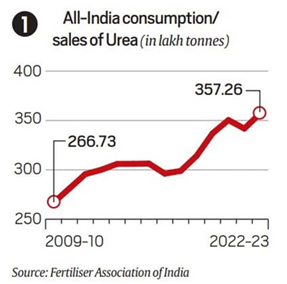

14th August 2023 (10 Topics)
Context
In order to boost the crop yields and maximise the use efficiency of imported nutrients, fortification of urea with micronutrients is a positive step.
Urea Gold Fertiliser
- The government recently launched ‘Urea Gold’ fertiliser.
- Developed by the state-owned Rashtriya Chemicals and Fertilizers Ltd (RCF), it is basically urea fortified with sulphur.
- Normal urea contains 46% of a single plant nutrient: Nitrogen or N.
- Urea Gold has 37% N plus 17% sulphur or Sand aims at two things.
- Deliver S along with N: The first is to deliver S along with N. Indian soils are deficient in S, which oilseeds and pulses – the country is significantly import-dependent in both – particularly require.
- Improve the nitrogen use efficiency (NUE): The second is to improve the nitrogen use efficiency (NUE) of urea. Coating of S over urea ensures a more gradual release of N. By prolonging the urea action, the plants stay greener for a longer time. Farmers tend to apply urea when they notice the leaves turning yellowish. If the crop retains greenness for an extended period, they would reduce the frequency of application and use, say, only two bags, as against three, for an acre of paddy or wheat.
|
What are the concerns?
- Urea is India’s most widely used fertiliser, with its consumption/sales rising from 26.7 million tonnes (mt) to 35.7 mt between 2009-10 and 2022-23.
- There are two concerns over rising urea consumption.
- Imported natural gas in production: The first is imports, which accounted for 7.6 mt out of the total 35.7 mt sold last fiscal. Even with regard to domestically-manufactured urea, the feedstock used – natural gas – is mostly imported. India’s nearly 36-mt annual consumption of urea is today next only to China’s 51 mt, with the latter’s production largely coal-based.

- Declining NUE: The second concern is NUE. Barely 35% of the N applied through urea in India is actually utilised by crops to produce harvested yields. The balance 65% N is unavailable to the plants, much of it “lost” through release into the atmosphere as ammonia gas or leaching below the ground after conversion into nitrate. Declining NUE, from an estimated 48% in the early 1960s, has resulted in farmers applying more and more fertiliser for the same yield.

What measures are required?
- A country with hardly any natural gas or rock phosphate, potash and sulphur reserves shouldn’t, beyond a point, encourage the consumption of these commodity fertilisers in plain-vanilla form.
- Instead, they must be coated with secondary nutrients (S, calcium and magnesium) as well as micronutrients (zinc, boron, manganese, molybdenum, iron, copper and nickel).
- Coating not only allows urea or DAP to be used as “carrier products” for delivering secondary and micro nutrients to crops.
- It improves their own N and P use efficiency through synergetic effects and controlled release that, in the case of urea, helps reduce losses through ammonia volatilisation and nitrate leaching.
Government measures to reduce Urea’s Consumption
- In 2015, the Centre made it mandatory to coat all indigenously manufactured and imported urea with neem oil.
- This was followed by replacing 50-kg bags with 45-kg ones in March 2018, and the launch of liquid ‘Nano Urea’ by the Indian Farmers’ Fertiliser Cooperative (IFFCO) in June 2021.



